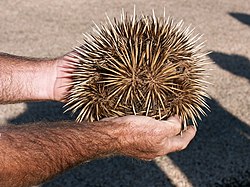Echidna
Echidna, the spiny anteater,[1] is a monotreme that lives in Australia and in New Guinea. They are the living members of the family Tachyglossidae.
| Echidna | |
|---|---|

| |
| Short-beaked echidna | |
| Scientific classification | |
| Unrecognized taxon (fix): | Tachyglossidae |
| Species | |
|
Genus Tachyglossus | |
Echnidas have a long, tube-like mouth with a sticky tongue. They are also covered in spines. They have mammary glands, and lay eggs.[2]
The echidna has a method of protecting itself. With its long, sharp claws, they quickly dig a hole until only their spines are showing when they are hiding in the hole. The predator is not be able to get it without injuring itself on the spines. When there is a fire, the echidna digs down out of reach of the fire.
Prey
The short-beaked echidna (Tachyglossus) eats termites and ants. The three Zaglossus species also eat other small insects and grubs. Echidnas pick up the prey with their sticky tongues. There is a separate page for Zaglossus.
Species
- Family Tachyglossidae
Echidna Media
Spines of the echidna
A short-beaked echidna building a defensive burrow in French Island National Park (43 seconds)
The Western long-beaked echidna, which is endemic to New Guinea
A short-beaked echidna curled into a ball; the snout is visible on the right
References
- ↑ Echidna Retrieved on 21 October 2007
- ↑ "7 things you might not know about echidnas". www.environment.sa.gov.au. Retrieved 2020-12-04.
Other websites
| Wikispecies has information on: Tachyglossidae. |
| Wikimedia Commons has media related to Lua error in Module:Commons_link at line 62: attempt to index field 'wikibase' (a nil value).. |
- Echidna Archived 2011-05-20 at the Wayback Machine




